[LESSON 1] - [LESSON 2] - [LESSON 3] - [LESSON 4]
Creating Fingerstyle Guitar Arrangements :: Lesson 2
Once the base arrangement has been completed, you will probably find that there are many voids where there are no notes in the upper or lower voices. It will be fairly easy for beginners to play, but probably will not be very satisfying and/or enjoyable to your listening audience. The next step is to fill those voids, so several arranging techniques will be discussed.
The base arrangement is shown below. If you look at measure one (1), notice that there both the upper and lower voice sustain through the second beat, so this is a potential spot to add notes to be played. If you look closely at each measure, you will find other places where voids appear. For instance beat four (4) in measures two (2) and three (3) have sustaining notes in both voices, more candidates for adding notes. In this lesson we will use an alternating bass to fill the voids.

Alternating Bass
Probably the most common technique for embellishing a base arrangement is to use an alternating bass. The arrangement has the chord root notes on beats one (1) and three (3), so the only thing needed is to add additional notes in each measure on beats two (2) and four (4).
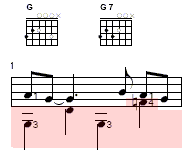
Measure 1
Measure 1 :: This measure contains a G and a G7 chord, so common
chord forms can be used, and the bass notes obtained form the chords. On beat two (2), the
open D on string four (4).is inserted. To obtain the
sound of the G7 in the last half of the measure, an
F on fret three (3) / string four (4) is inserted. Play the
first part of the sound clip below to hear the result and notice how you hear the chord changes
from G to a
G7.
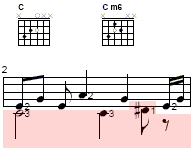
Measure 2
Measure 2 :: There is a slight problem in this measure.
The melody drops down to string four (4), so the alternating bass cannot be used as one would
normally expect. This confirms the premise that the melody should be confined to the upper three
strings. As a work around, the alternating bass on beat two (2) is not entered. However, it
can be entered on beat four (4). To lead the listener to hearing the chord change to Cm, a D# is entered as the
alternating bass on fret one (1) / string three (3). Notice the melody drops down to fret
four (4) on the second half of beat four (4), so the D# is
entered as a 1/8th note and a 1/8th rest is added to complete the lower voice count. Correct
standard notation dictates that each voice must contain notes and/or rests to provide a complete
count. In this case four complete beats.
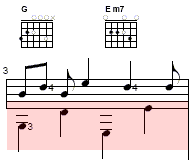
Measure 3
Measure 3 :: This measure is straight forward, enter the
appropriate notes on beats two (2) and four (4) from the chord forms.
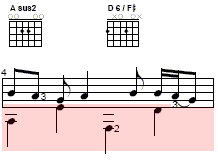
Measure 4
Measure 4 :: Again this measure is fairly straight forward. If you look at the base arrangement, an open D is entered on beat three (3) in the lower voice. However to get an alternating bass, it is common practice to substitute an F# on fret two (2) / string six (6) in place of the D-root, then use the open-D on fret four (4) as the bass note on beat four (4) to get the alternating bass.
A similar approach is used to complete the alternating bass on the remaining measures. The image below shows the final alternating bass arrangement.
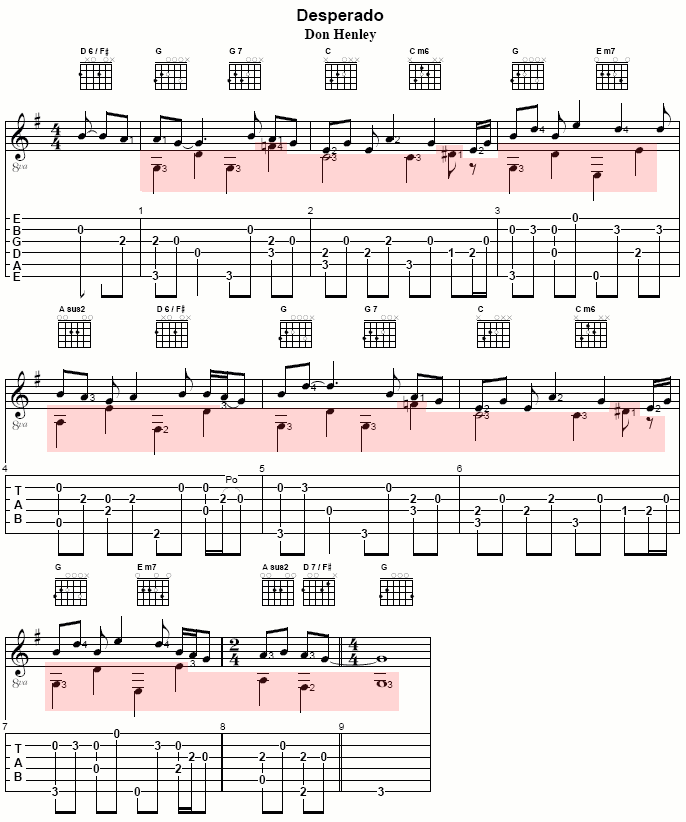
Now this sounds much better as the voids in the base arrangement have been filled. This lesson demonstrated how easy it is to create an alternating bass arrangement which in many cases may be what you want. However, quite often you will hear players forcing songs into an alternating bass arrangement even though the bass in the original recording has a greater degree of syncopation. In the next lesson, several alternate techniques will be applied to the base arrangement to give it an entirely different sound.
Before proceeding, a couple of comments on this arrangement. Notice chord diagrams were added and suggested left-hand fingerings inserted into the standard notation. If your notation program provides these features, you are encouraged to add them to your arrangements. They are a great benefit to those that are trying to learn your arrangement and are invaluable when you come back to re-learn it.